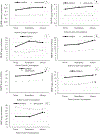Associations between school lunch consumption and urinary phthalate metabolite concentrations in US children and adolescents: Results from NHANES 2003-2014
- PMID: 30223205
- PMCID: PMC6221921
- DOI: 10.1016/j.envint.2018.09.009
Associations between school lunch consumption and urinary phthalate metabolite concentrations in US children and adolescents: Results from NHANES 2003-2014
Abstract
Diet is a major route of phthalate exposure in humans due to use in food packaging materials. School lunches may be an important contributor to phthalate exposure in children and adolescents in the US because of the large amount of packaging necessary for mass-produced foods. We used 2003-2014 National Health and Nutrition Examination Survey data to study the association between school lunch consumption and urinary phthalate metabolite concentrations in children (ages 6-11 years, N = 2196) and adolescents (ages 12-19 years, N = 2314). After adjustment for other covariates, children who Always consumed school lunch had significantly elevated urinary concentrations of the following phthalate metabolites compared to levels in children who Never ate school lunch: sum of di(2‑ethylhexyl) phthalate metabolites, (28% higher, 95% confidence interval, CI: 10, 49%); mono‑(carboxy‑octyl) phthalate (MCOP; 43% higher, 95% CI: 17, 76%) and mono‑n‑butyl phthalate (18% higher, 95% CI: 3.5, 34%). We did not find statistically significant associations in adolescents, but the trend for MCOP concentrations was similar to that of children. In sensitivity analyses, associations between 24-hour recall of cafeteria food and urinary phthalate metabolites were not statistically significant, which could indicate that associations observed with Always consuming school lunch are due to residual confounding. Our findings show that children who Always eat school lunch had higher levels of exposure to some phthalates, but the source of differences in exposure need to be evaluated in additional studies.
Keywords: Cafeteria; Diet; Endocrine disruptors; Exposure assessment; Phthalates; Plasticizers.
Published by Elsevier Ltd.
Figures


Similar articles
-
Dietary correlates of urinary phthalate metabolite concentrations in 6-19 Year old children and adolescents.Environ Res. 2022 Mar;204(Pt B):112083. doi: 10.1016/j.envres.2021.112083. Epub 2021 Sep 25. Environ Res. 2022. PMID: 34582800 Free PMC article.
-
Age and sex differences in childhood and adulthood obesity association with phthalates: analyses of NHANES 2007-2010.Int J Hyg Environ Health. 2014 Jul;217(6):687-94. doi: 10.1016/j.ijheh.2014.02.005. Epub 2014 Mar 5. Int J Hyg Environ Health. 2014. PMID: 24657244 Free PMC article.
-
Urinary phthalate metabolites and metabolic syndrome in U.S. adolescents: Cross-sectional results from the National Health and Nutrition Examination Survey (2003-2014) data.Int J Hyg Environ Health. 2019 Mar;222(2):195-204. doi: 10.1016/j.ijheh.2018.09.005. Epub 2018 Oct 5. Int J Hyg Environ Health. 2019. PMID: 30297147 Free PMC article.
-
Predictors of urinary bisphenol A and phthalate metabolite concentrations in Mexican children.Chemosphere. 2013 Nov;93(10):2390-8. doi: 10.1016/j.chemosphere.2013.08.038. Epub 2013 Sep 14. Chemosphere. 2013. PMID: 24041567 Free PMC article.
-
Phthalates and the diets of U.S. children and adolescents.Environ Res. 2013 Oct;126:84-90. doi: 10.1016/j.envres.2013.07.007. Epub 2013 Sep 13. Environ Res. 2013. PMID: 24041780
Cited by
-
Protective effects of polyphenols against endocrine disrupting chemicals.Food Sci Biotechnol. 2022 Jul 12;31(8):905-934. doi: 10.1007/s10068-022-01105-z. eCollection 2022 Jul. Food Sci Biotechnol. 2022. PMID: 35873371 Free PMC article. Review.
-
Association of urinary phthalate metabolites with all-cause and cardiovascular disease mortality among adults with diabetes mellitus: National Health and Nutrition Examination Survey 2005-2014.Front Public Health. 2023 May 30;11:1178057. doi: 10.3389/fpubh.2023.1178057. eCollection 2023. Front Public Health. 2023. PMID: 37325320 Free PMC article.
-
Dietary correlates of urinary phthalate metabolite concentrations in 6-19 Year old children and adolescents.Environ Res. 2022 Mar;204(Pt B):112083. doi: 10.1016/j.envres.2021.112083. Epub 2021 Sep 25. Environ Res. 2022. PMID: 34582800 Free PMC article.
-
Ultra-processed food consumption and exposure to phthalates and bisphenols in the US National Health and Nutrition Examination Survey, 2013-2014.Environ Int. 2019 Oct;131:105057. doi: 10.1016/j.envint.2019.105057. Epub 2019 Aug 6. Environ Int. 2019. PMID: 31398592 Free PMC article.
-
Distribution and Dietary Predictors of Urinary Phthalate Metabolites among Pregnant Women in Shanghai, China.Int J Environ Res Public Health. 2019 Apr 16;16(8):1366. doi: 10.3390/ijerph16081366. Int J Environ Res Public Health. 2019. PMID: 30995748 Free PMC article.
References
-
- Gray LE Jr., Wilson VS, Stoker T, et al. Adverse effects of environmental antiandrogens and androgens on reproductive development in mammals. International journal of andrology 2006;29(1):96–104. - PubMed
-
- Huang HB, Kuo PL, Chang JW, Jaakkola JJ, Liao KW, Huang PC. Longitudinal assessment of prenatal phthalate exposure on serum and cord thyroid hormones homeostasis during pregnancy-Tainan birth cohort study (TBCS). Science of The Total Environment 2018;619:1058–1065. - PubMed
-
- Huang PC, Kuo PL, Guo YL, Liao PC, Lee CC. Associations between urinary phthalate monoesters and thyroid hormones in pregnant women. Human reproduction 2007;22(10):2715–2722. - PubMed
Publication types
MeSH terms
Substances
Grants and funding
LinkOut - more resources
Full Text Sources
Other Literature Sources
Research Materials

